
In the US dairy industry, young calves are often transported soon after birth. A portion of the female calves (referred to as “replacement heifers”) are often reared off site by specialized operations until they are ready to give birth and produce milk. The remainder, as well as the males are “surplus” and usually slated to become veal or “dairy beef.”
AWI research has revealed that, in service to this model, the industry routinely subjects hundreds of thousands of young, unweaned calves to stressful journeys of up to 1,000 miles or more throughout the country, particularly between the Upper Midwest and the Southwest.
Click maps to view.
The Investigation
While researching shipments of young calves from Canada to the United States, AWI received state records documenting frequent shipments of large number of calves under 1 month of age from northern dairy-producing states to calf-rearing farms in Texas, New Mexico, Arizona, and California. To investigate further, AWI requested export records from 6 of the 10 largest dairy-producing states—California, Minnesota, New York, Michigan, Idaho, and Wisconsin. AWI also received import records from New Mexico and California—home of dozens of calf ranches.
Numbers of Neonatal Calves (Under One Month of Age) Transported
from Six of the Top Ten Dairy Producing States in 2022*

To confirm what the records revealed, we partnered with the nonprofit organization Animals’ Angels to monitor a truckload of 1-week-old calves on a 1,113-mile journey from a mega-dairy in Hancock, Minnesota, to a calf ranch in Texico, New Mexico. Animals’ Angels investigators followed the calves as they traveled through Minnesota, South Dakota, Nebraska, Kansas, and Texas before reaching their destination in New Mexico, 19 hours after leaving the origin dairy.
The investigators documented the calves’ condition on two occasions, once about 2 hours into the trip and again 9 hours later (11 hours after leaving the Minnesota dairy). During the first observation, the investigators noted ear tags confirming the calves were around 1 week old, as well as the presence of the calves’ umbilical cords, meaning their navel were unhealed and could easily become infected. Some of the calves were observed being stepped on by other animals due to overcrowding on the truck. At the 11-hour mark, all the calves appeared to be standing, and many were bellowing in the 100°F heat—a sign of distress. The investigators were unable to observe the animals’ condition during the final 8 hours of the journey or during unloading at the calf ranch in New Mexico.
The Problem
Transport is very stressful for animals. In addition to the vibration, noise, fumes, and unfamiliar environments, transported animals often experience prolonged food and water deprivation, intense crowding, exposure to extreme heat and cold, and physical stress and injuries from rough handling and having to balance in a moving truck. These stressors negatively affect animal health and welfare. Stress also lowers an animal’s resistance to infection; consequently, transport stress also contributes to the spread of disease (including zoonotic diseases that can jump to humans) and to meat contamination.
In a fact sheet titled, “Stress in Farm Animals and Food Safety: Is There a Connection?” the USDA confirms the negative impact of transport on animal health and welfare:
“The handling, loading, transporting and unloading of animals can have substantial detrimental effects on their well-being by causing stress. … Stress reduces the fitness of an animal, which can be expressed through failure to achieve production performance standards or targets, or more drastically, through injury, disease and death.”
Transporting neonatal calves over long distances is particularly troublesome, as it significantly increases the risk that they will contract disease or die during or shortly after shipping. Several contributing factors are identified in the scientific and veterinary literature, including (1) immature immune function in young calves, (2) immunosuppressive effects of transport stress, (3) high levels of pre-transport illness and disease in young calves, and (4) mixing of calves from different facilities. The resulting higher rates of disease lead to high mortality rates during and after transport. Calves in transport are also routinely administered antibiotics—both to buffer their systems against the stressful conditions and to treat and contain disease in the weeks after transport. Systematic use of antibiotics to mitigate the effects of chronic stressors is known to contribute to antibiotic resistance—a threat to both humans and animals.
The Solution
Long-distance journeys such as those described here violate the standards of the World Organisation for Animal Health (WOAH), as well as regulations of Canada, the United Kingdom, and the European Union. WOAH has established welfare standards for animals transported by sea and land. Both codes include criteria for determining whether an animal is fit to travel.
According to WOAH, animals are unfit to travel by land if they are any of the following:
- Sick, injured, weak, disabled or fatigued
- Unable to stand unaided and bear weight on each leg
- Blind in both eyes
- Unable to be moved without causing them additional suffering
- Newborn with an unhealed navel*
- Pregnant and in the final 10% of their gestation period at the planned time of unloading
- Female who has given birth within the previous 48 hours
- In a body condition that would result in poor welfare because of the expected climatic conditions
* Scientific research has demonstrated that, in cattle, “navel healing” should be defined as the scarring of the umbilical wound, which occurs no earlier than 3–4 weeks of age
After significant encouragement from AWI and our supporters, the USDA adopted the WOAH criteria for the export of farmed animals from the United States by sea. AWI is now asking that the WOAH fitness to travel criteria be adopted for the transport of farmed animals domestically between states under the federal Animal Health Protection Act.
In August 2022, AWI submitted comments to the National Milk Producers Federation, an industry trade group, on its FARM animal care standards. We urged the industry to amend its standards by adopting the WOAH fitness to travel requirements or, at minimum, acknowledge in its standards that calves under 3 weeks of age are unfit for transport. The federation failed to incorporate the requested change.
Take Action
Animal advocates can help farmed animals gain protections from unnecessary stress and suffering by telling the dairy industry and the USDA to stop the long-distance transport of especially vulnerable animals. Click on the link below to send your message.

